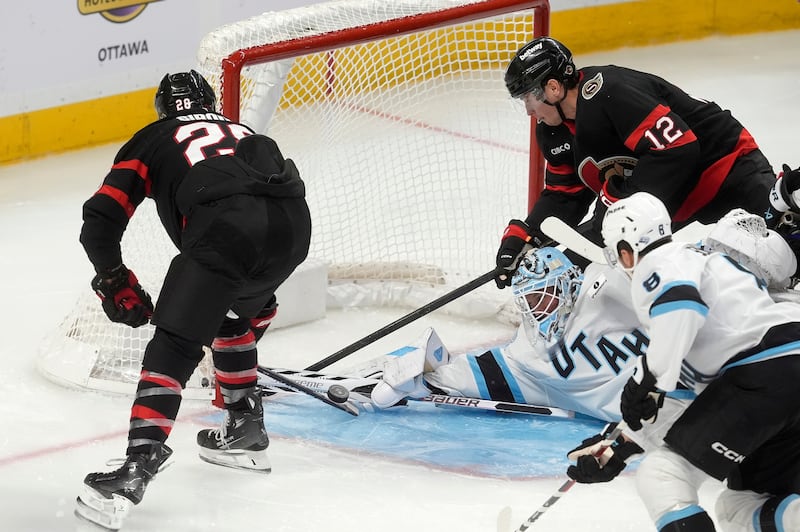It’s obvious that things are going wrong for the Utah Mammoth, but what level of worrying is acceptable?
Their 4-2 loss to the Ottawa Senators on Sunday is yet another kick to their confidence, but what does it indicate about their season as a whole?
The simple answer is this: They’re probably not as good as they looked at the beginning of the season, and they’re probably not as bad as their record indicates over the last six games.
That being said, there are a few things that need to change.
Can’t get far without good goaltending
Hall of Fame goaltender Henrik Lundqvist separated his goals against into two categories: Those that he should have saved and those that were unstoppable.
If he didn’t particularly stand a chance on most of the goals over a given period of time he could relax knowing he did what he could, but when too many were in the other category, he knew he might be in trouble.
By that metric, Utah’s goaltending is in trouble.
Of the four goals Vítek Vaněček allowed on Sunday, one was egregious: Nick Cousins’ weak wraparound bid. The other three weren’t necessarily in the “should have” category, but they could definitely be classified as “could have.”
And it’s not just Vaněček. In Montreal on Saturday, Karel Vejmelka should arguably have saved at least four, maybe five of the six goals he allowed.
Alain Vigneault, who coached more than 1,500 games (regular season and playoffs combined) from 1997 to 2022, broke down the most important position plainly.
“Hockey is simple,” he said. “If your goalie is better than my goalie, I win. If my goalie is better than your goalie, I win.”
Per Natural Stat Trick’s data, Vejmelka ranks last in the league in terms of goals saved above average at 5-on-5 — a stat that isolates a goalie’s individual impact on the game. Vaněček isn’t far behind, with the 14th-worst rating in that column.
The conventional goalie stats don’t do them any favors, either: Vejmelka has the “better” save percentage of the two at a brutal .881. Vaněček’s goals-against average tops that of his partner at a mediocre 2.85.
If the Mammoth are going to turn this season around, at least one of those goalies will have to find his game.
Keller, Schmaltz said ‘enough is enough’ — but is that enough?
Utah has not scored much on their organic chances lately. At the end of a road trip when that was the case in almost every game, Clayton Keller set out to change that.
On what seemed like a routine zone entry to end a power play, he turned on the jets and flew past Ottawa’s defensemen. He didn’t score on his first shot, but he negotiated the rebound before Leevi Meriläinen knew what hit him.
Keller wasn’t going to take no for an answer on that one.
Later on, Nick Schmaltz did the same thing, beating Jake Sanderson wide and tucking the puck under an outstretched pad.
It wasn’t enough to win Utah the game, but it did end the first line’s cold streak. But, as was the case in the previous games on this trip, it’s not enough to have just one line going.
“You’re going to need all four lines throughout the season,” Schmaltz said after the game. “It’s not just relying on (the) first or fourth or whatever line it may be. Good teams get contributions from everyone.”
Was Jack McBain’s goal actually goaltender interference? It’s not as simple as you’d think
The Senators surprised a lot of people by challenging Jack McBain’s goal early in the third period for goaltender interference. It was probably a 50/50 call, and they risked a two-minute penalty in a tight situation if they were to get it wrong.
But the officials agreed with the Senators, dropping the score back to 3-2.
Mammoth fans are understandably upset to have a goal taken down, but was it objectively the right call?
The argument from Mammoth fans is that Meriläinen had plenty of time to reset after McBain contacted him. However, the NHL rule book doesn’t actually establish a time frame for contact to factor into the call.
Instead, it simply says a goal should be disallowed if “an attacking player, either by his positioning or by contact, impairs the goalkeeper’s ability to move freely within his crease or defend his goal."
By that judgement alone, the officials would have been right to disallow the goal, but there is one more important factor: The image below shows that the contact was initiated outside the crease.

Table 16 in the rule book offers a case-by-case scenario guide for the appropriate call in any possible situation. Section 2B of that table covers the event that the contact happens outside the crease and a goal is scored — and in that case, it is allowed.
Knowing that the contact happened where it did, that goal should have stood.
Had it counted, the score would have been 3-3, and the Mammoth would have had a power play during which they could have attempted to take the lead.
Additionally, the Senators’ fourth goal would almost certainly not have happened because the Mammoth would have still been on the power play at that time.
Hockey is not a game of what-ifs, though, and unfortunate calls happen to every team. What matters is how you respond to it, and that was the difference in this one.
Goal of the game
Clayton Keller takes matters into his own hands
What’s next?
The Mammoth will sleep in their own beds this week — something they’ve hardly been able to do this season.
They have a rematch with the Buffalo Sabres on Wednesday, followed by a date with the New York Islanders on Friday. These are both conquerable teams, which could provide the cure to the Mammoth’s woes.

